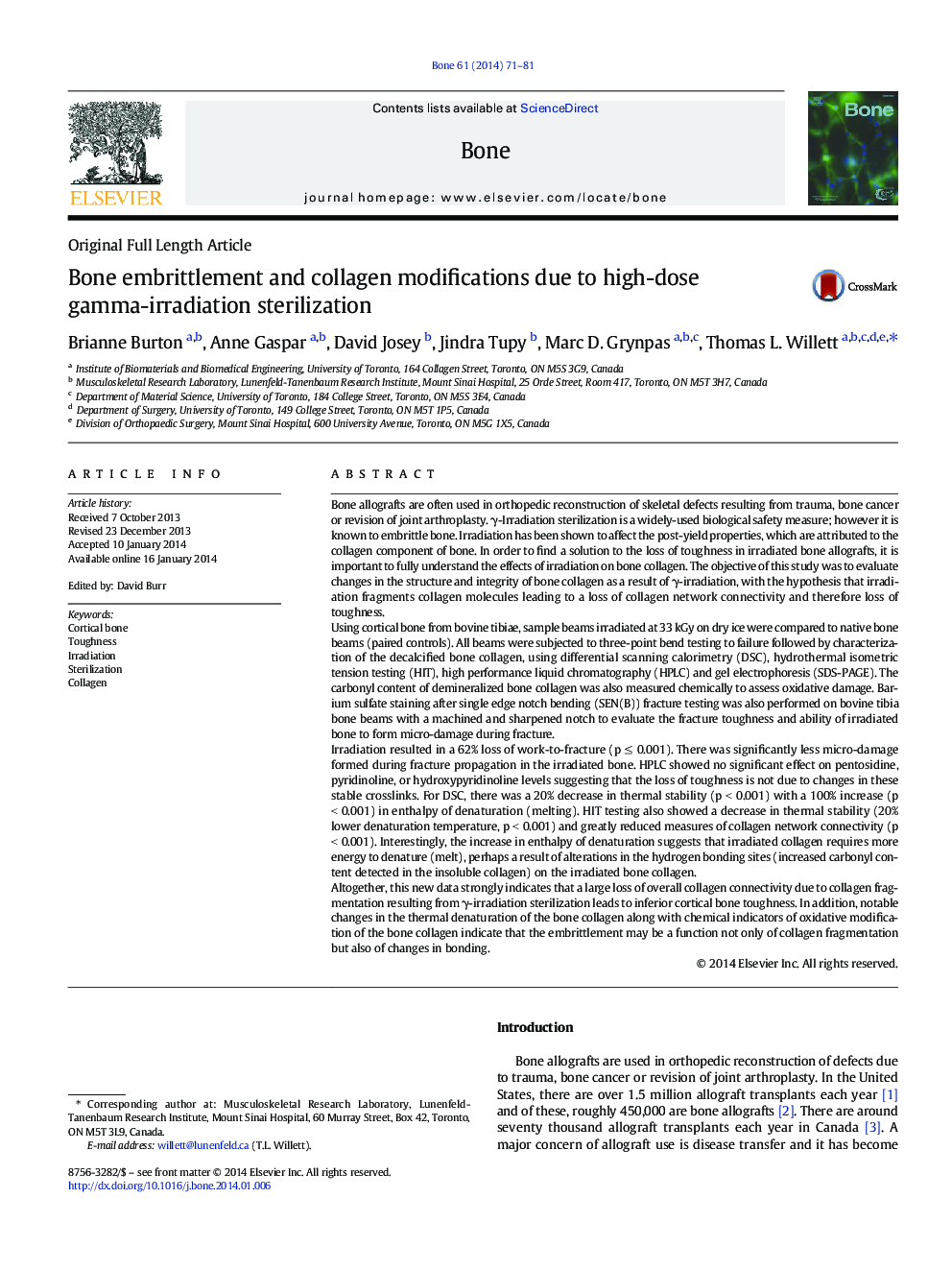| کد مقاله | کد نشریه | سال انتشار | مقاله انگلیسی | نسخه تمام متن |
|---|---|---|---|---|
| 5890251 | 1568158 | 2014 | 11 صفحه PDF | دانلود رایگان |
- Irradiation sterilization at 33Â kGy embrittles bovine cortical bone and decreases deformation-induced micro-damage formation during fracture.
- Embrittlement is caused largely by a loss of collagen network connectivity resulting from collagen molecule fragmentation.
- Oxidative changes to the collagen may also contribute to embrittlement via changes in heat labile non-covalent bonding.
Bone allografts are often used in orthopedic reconstruction of skeletal defects resulting from trauma, bone cancer or revision of joint arthroplasty. γ-Irradiation sterilization is a widely-used biological safety measure; however it is known to embrittle bone. Irradiation has been shown to affect the post-yield properties, which are attributed to the collagen component of bone. In order to find a solution to the loss of toughness in irradiated bone allografts, it is important to fully understand the effects of irradiation on bone collagen. The objective of this study was to evaluate changes in the structure and integrity of bone collagen as a result of γ-irradiation, with the hypothesis that irradiation fragments collagen molecules leading to a loss of collagen network connectivity and therefore loss of toughness.Using cortical bone from bovine tibiae, sample beams irradiated at 33 kGy on dry ice were compared to native bone beams (paired controls). All beams were subjected to three-point bend testing to failure followed by characterization of the decalcified bone collagen, using differential scanning calorimetry (DSC), hydrothermal isometric tension testing (HIT), high performance liquid chromatography (HPLC) and gel electrophoresis (SDS-PAGE). The carbonyl content of demineralized bone collagen was also measured chemically to assess oxidative damage. Barium sulfate staining after single edge notch bending (SEN(B)) fracture testing was also performed on bovine tibia bone beams with a machined and sharpened notch to evaluate the fracture toughness and ability of irradiated bone to form micro-damage during fracture.Irradiation resulted in a 62% loss of work-to-fracture (p â¤Â 0.001). There was significantly less micro-damage formed during fracture propagation in the irradiated bone. HPLC showed no significant effect on pentosidine, pyridinoline, or hydroxypyridinoline levels suggesting that the loss of toughness is not due to changes in these stable crosslinks. For DSC, there was a 20% decrease in thermal stability (p < 0.001) with a 100% increase (p < 0.001) in enthalpy of denaturation (melting). HIT testing also showed a decrease in thermal stability (20% lower denaturation temperature, p < 0.001) and greatly reduced measures of collagen network connectivity (p < 0.001). Interestingly, the increase in enthalpy of denaturation suggests that irradiated collagen requires more energy to denature (melt), perhaps a result of alterations in the hydrogen bonding sites (increased carbonyl content detected in the insoluble collagen) on the irradiated bone collagen.Altogether, this new data strongly indicates that a large loss of overall collagen connectivity due to collagen fragmentation resulting from γ-irradiation sterilization leads to inferior cortical bone toughness. In addition, notable changes in the thermal denaturation of the bone collagen along with chemical indicators of oxidative modification of the bone collagen indicate that the embrittlement may be a function not only of collagen fragmentation but also of changes in bonding.
Journal: Bone - Volume 61, April 2014, Pages 71-81
